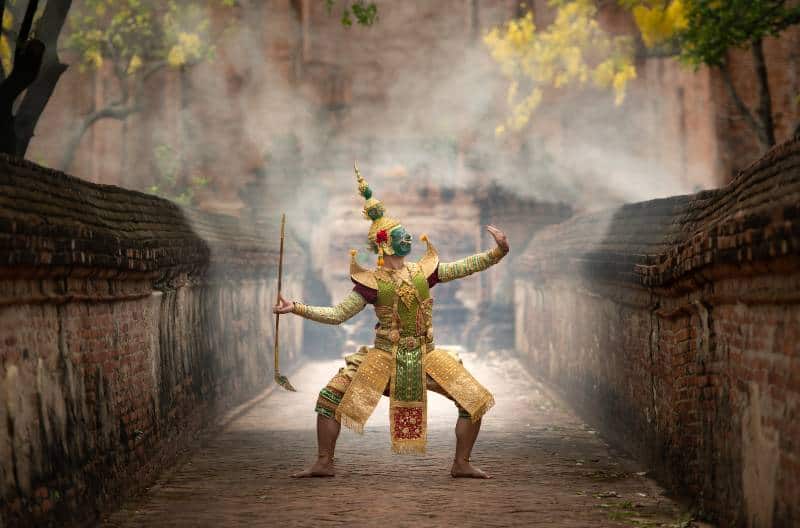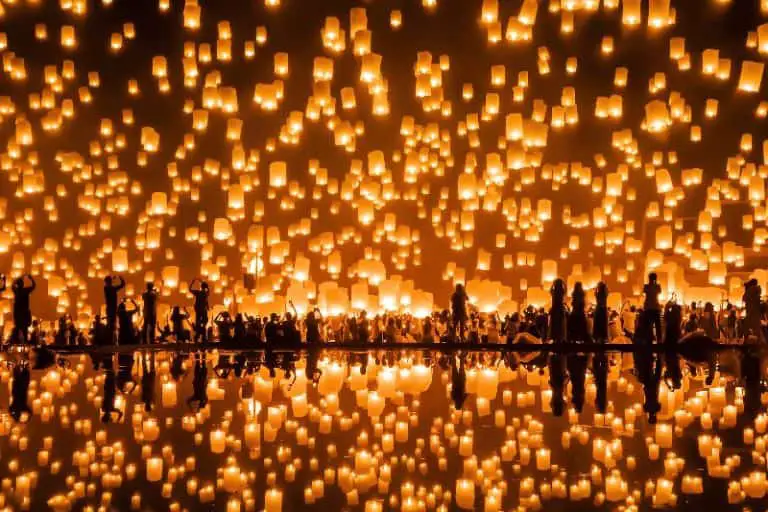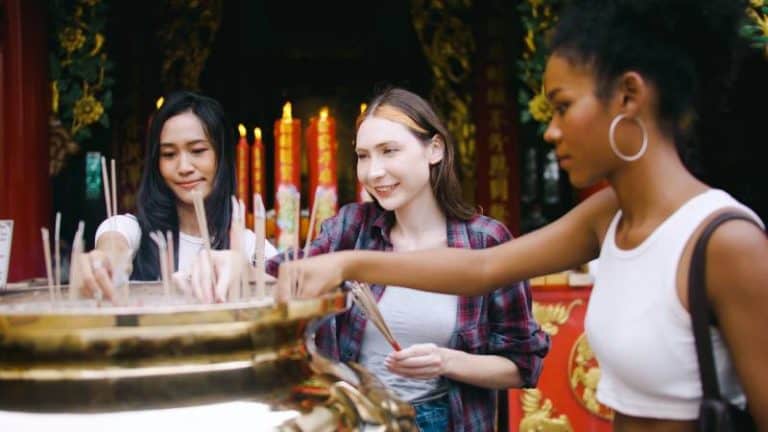Thailand’s Culture and Art: A Fascinating Exploration
From the beauty of its temples to the trendiness of its night markets, Thailand is full of exciting cultural experiences. Since ancient times, art has been an integral part of Thai culture – from traditional painting and dance all the way to modern fashion and cuisine. This rich artistic heritage helps make this Southeast Asian nation a unique destination for travelers looking to explore new places and enriching perspectives on life. In this blog post, we’ll dive into what makes up Thailand’s culture and art scape: exploring how traditional arts have stood the test of time while staying relevant in today’s world. Read on as we take you on a journey that reveals why you should experience Thailand’s stunning customs!
Traditional Thai art is strongly influenced by Buddhism, however contemporary artwork has incorporated modern techniques and traditional styles to create something entirely unique.
Key Takeaways
- Ancient Buddhist art has deeply impacted Thai visual arts.
- Traditional Thai crafts like textiles and decorations have a unique local flair.
- Modern Thai art adds an exciting perspective to the region’s well-preserved culture. Thailand is a great place to explore and experience unique cultural expressions through its vibrant markets, galleries, festivals, and more! No matter what style of art appeals to you, exploring Thailand’s art scene will leave you with unforgettable memories

Thai Culture
Religion
Immersed in the spiritual essence of Thai culture, Buddhism embodies not only a religion but a distinctive way of life for the people of Thailand. Unlike other countries, Thailand has maintained its foundational roots in Buddhism, with over 95% of the population following the Theravada Buddhist sect.
The influence of this wisdom tradition can be observed in the daily conduct and the intricate nuances of Thai life, shaping the collective mind of the nation. While Buddhism may take center stage in Thailand, the country is also a beacon of religious tolerance, embracing diverse faiths such as Islam in provinces bordering Malaysia, Christianity, and smaller sects consisting of Hinduism, Sikhism, and Confucius Ethics.
Thailand’s commitment to religious harmony is exemplified in its very governance with the King acting as a unifying figure and protector of all religions, reaffirming the freedom of worship that truly encapsulates the essence of Thai culture.
Food and Cuisine
Thai cuisine is deeply intertwined with the nation’s culture, playing an essential role in bringing people together and fostering a sense of community. The sociable nature of Thai people is beautifully complemented by the unique aspects of their food culture, wherein dishes are ordered, served, and consumed in a manner that promotes sharing and bonding with family and friends.
At the heart of a delectable Thai meal are five principal flavors – salty, sweet, sour, bitter, and spicy – which must harmoniously blend together to create a truly satisfying culinary experience. While the heat of Thai spices might challenge an unaccustomed palate, the emphasis on striking a perfect balance amongst all the flavors results in a rich and memorable dining adventure.
Festivals and Celebrations
Chinese New Year (January or February)
Thai culture is incredibly vibrant, especially when it comes to the numerous festivals and celebrations throughout the year. One such celebration is the Chinese New Year, which occurs in January or February depending on the lunar calendar. With a significant Chinese population, particularly in areas such as Bangkok and Phuket, Thailand enthusiastically embraces this holiday, making it one of the biggest and most festive events in the country.
Bangkok’s lively Chinatown, known as Yarowaraj, is the epicenter of these festivities – narrow alleyways come to life with an array of colorful dragon and lion dances, enthusiastic parades, lively firecrackers, and mesmerizing lanterns illuminating the streets. And, of course, the already renowned street food vendors of Chinatown step up their game, serving a mouthwatering array of delectable dishes – the perfect way to indulge in the excitement and flavors of Thai culture at its finest.
Songkran – Water Festival
Thai culture is filled with vibrant festivals and celebrations, with Songkran being the most prominent and exciting of them all. This incredible event not only commemorates the Thai New Year but also turns the entire country into an exuberant water fight. Originating in the 13th century, Songkran’s water-throwing tradition began as sacred rituals to cleanse the previous year’s misdeeds by sprinkling water on Buddha statues.
Nowadays, people enthusiastically throw water at one another, regardless of nationality, ensuring everyone is drenched and the celebratory spirit is shared. While this is a delightful aspect of Thai culture, it is essential to remain respectful, particularly when visiting temples or religious sites during Songkran. As one of Thailand’s most significant Buddhist holidays, engaging in these festivities allows you to fully immerse yourself in the richness of Thai traditions.
Boon Bang Fai – Rocket Festival (May)
The Boon Bang Fai, or Rocket Festival, ignites the sky with vibrant spectacles as farming communities in the Isan region of northeastern Thailand and neighboring Laos gather to celebrate the onset of the wet season. This lively pre-planting affair unites villages in a whirlwind of Thai classical music, folk dance shows, and colorful pageantry before the hard work of the planting season begins.
Homemade rockets made from bamboo take center stage as they are paraded through the streets on elaborately decorated floats. But the true highlight of the festival occurs on the third day when these crafted rockets are launched skyward.
Participants revel in the thrill of friendly competition, as their rockets are judged not only on the height and distance of their launch but also on the captivating elegance of their vapor trails. All the while, the camaraderie is further bolstered, and spirits are lifted, by an abundant flow of rice wine shared among the attendees.
To learn about other places in Thailand which celebrate, read this article!
Traditional Clothing
Traditional Thai clothing, known as chut thai, demonstrates the beautiful craftsmanship and unique design rooted in Thailand’s rich cultural heritage. Worn by people of all ages and genders, these distinctive garments showcase the colorful artistry and skilled tailoring found in Thai culture.
Women typically wear a chut thai ensemble that includes a pha nung or a pha chung hang, which are types of wrapped skirts, along with a blouse and a pha biang, a traditional shawl or sash.
The vibrant patterns, exquisite embroidery, and intricate details of these outfits serve as a reflection of Thailand’s diverse history, blending local traditions with influences from other Asian countries. Donning these traditional garments is not only a way to pay homage to Thailand’s past but also a means of celebrating its bright future.
Thai Art
Visual Arts (Paintings, Sculptures, and Crafts)
Thai art, an intricate blend of both unique and culturally influenced styles of traditional thai art, showcases a beautiful and diverse array of visual arts.
Within these artistic expressions, one can find remarkable sculptures, paintings, crafts, fine arts, and textiles which showcase the creativity and skill of the artisans. Tracing its roots back to prehistoric times, early Thai art reveals magnificent bronze work and stone carvings from the Dvaravati civilization.
Furthermore, the country’s rich artistic history extends to a myriad of decorative arts, such as lacquerware and ceramics. Showcased in various museums and galleries, the allure of Thai art not only highlights the nation’s proud heritage but also invites a deeper understanding of its complex and mesmerizing past.
Performing Arts (thai Dance, Music, and Theater)
While visiting Thailand, a fantastic way to immerse yourself in the rich local culture and unwind after a long day of exploration is by attending a captivating night show. Major tourist destinations throughout the country boast high-quality performances that feature talented artists, mesmerizing costumes, and an electrifying ambiance.
There are two predominant traditional forms of Thai theater, namely khon, and lakhon. Developed in the 15th century, the more dynamic khon was historically performed to entertain the royal court, while the elegant lakhon was initially reserved for palace audiences, characterized by its slower, graceful movements.
Both theatrical forms are accompanied by a piphat, a small orchestral ensemble, providing an authentic, delightful experience that you won’t want to miss.
Traditional or folk
Luk thung
Delving into the rich tapestry of Thai art, one cannot ignore the captivating charm of its performing arts scene, which encompasses classical dance, music, and theater. Among these, Luk thung, a genre of Thai country music, has resonated powerfully with audiences since its inception in the mid-20th century. Its soulful melodies and relatable lyrics encapsulate the daily struggles faced by rural Thais, painting vivid images of their lives.
Two standout artists in Luk thung’s early days were Ponsri Woranut and Suraphol Sombatcharoen, innovators who skillfully blended diverse influences from Latin America, Asia, and American film soundtracks and country music. One city has significantly impacted the evolution of Luk thung – Suphanburi.
This central city produced a galaxy of eminent artists, including the legendary Pumpuang Duangjan, who spearheaded the electronic Luk thung movement. The growing influence and popularity of the thai version of Luk thung ultimately led to the establishment of an all Luk thung radio station in 1997, opening doors for Thai country music to reach even greater heights.
Architecture and Design
Thai art, specifically in the realm of architecture and design, beautifully blends time-honored Asian influences with Thai contemporary art trends, resulting in a breathtaking fusion that is uniquely Thai. Major cities like Bangkok proudly display this captivating aesthetic through their stunning high-rise buildings and skyscrapers, placing Thai architecture on the global stage.
In contrast, projects on a smaller scale reveal the ingenuity of Thai architects, who seamlessly blend interior and exterior spaces as a means of coping with the region’s intense weather conditions. This striking combination of innovation and preservation creates a colorful tapestry of architectural masterpieces that captivates visitors and locals alike. Through a close examination of Thai architecture projects, interviews, and events, one can truly appreciate the vibrant nature and magnificent prowess of Thai design.
Influences on Thailand’s Culture and Art
Historical Influences
The rich tapestry of Thailand’s culture and art has been woven together by a fascinating array of historical influences. The early roots of Thai art can be traced back to the indigenous civilizations of the Mon and Khmer, each of which left an indelible mark on the development of aesthetics in the region. As the world-renowned Sukhothai and Ayutthaya periods unfolded, Thai art began to flourish and establish its own unique style.
This period saw the incorporation of diverse artistic influences from other Asian cultures, most notably those of Sri Lanka, Japan, and China. This remarkable synchronization of various artistic traditions ultimately resulted in the creation of a distinct and captivating Thai cultural identity, celebrated and admired by art enthusiasts across the globe.
Regional and Global Influences
Thailand’s rich cultural heritage and art have been significantly influenced by both regional and global factors. Among these, Buddhism stands out as a major force, impacting various aspects of Thai art, such as architecture, sculpture, and painting.
Some of the most stunning examples of this influence can be seen in the ancient wat structures found in Ayutthaya, the nation’s capital from the 14th to the 18th century, and in Chiang Mai.
These temples showcase typical Thai craftsmanship, where the framework is generally constructed from wood, while brick and plaster comprise the walls. Chiang Mai is particularly steeped in history, with numerous Buddhist temples nestled both within and outside the still-standing ancient city walls.
Interestingly, even contemporary ritual and ceremonial halls adhere to traditional designs – exhibiting curved finials, high-pitched roofs, intricately carved doors and windows, and stairways flanked by naga, or giant snakes. This blend of the old and the new is a testament to the enduring charm and beauty of Thai art and culture.
Preservation and Promotion of Thailand’s Culture and Art
Government Initiatives
The preservation and promotion of Thailand’s culture and art through government initiatives have been instrumental in revitalizing the local craft industry and fostering its global outreach, particularly in light of the post-coronavirus era. These concerted efforts have paved the way for Thai designers to display their resilience and adaptability in these challenging times by crafting innovative solutions that cater to various aspects of the current crisis.
Showcasing the talent of 47 designers and brands, these solutions comprise creative, design, growth, green, and art-centric approaches, which encapsulate not only the rich cultural heritage of Thailand but also the forward-thinking and eco-friendly mindset of its artistic community. By merging the traditional with the contemporary, Thai culture and art continue to endure and flourish on the global stage.
Private Sector Initiatives
The collaborative efforts between ThaiBev, the government, and the private sector demonstrate a strong dedication to preserving and promoting Thailand’s rich cultural heritage. By focusing on three main strategies – conservation, cooperation, and creation – ThaiBev aims not only to raise public awareness of the nation’s artistic and cultural treasures but also to instill a sense of pride and love for these invaluable resources. Furthermore, this partnership seeks to infuse the vibrant Thai identity into both the ASEAN region and the international community as a whole.
One major aspect of this initiative involves providing new generations with opportunities to explore various branches of art and culture beyond traditional classroom settings. By taking such an inclusive and innovative approach, these joint efforts have the potential to significantly enhance the appreciation and expression of Thailand’s unique art and culture, ensuring its continued growth and vitality well into the future.
Challenges and Future Directions
The preservation and promotion of Thailand’s culture and art, particularly in the performing arts sector, have faced significant challenges amidst the COVID-19 pandemic.
With many practitioners struggling to make ends meet and the gravitation of audiences toward virtual experiences, the future of this vibrant cultural realm may appear uncertain. However, the collaborative efforts of organizations like the Creative Economy Agency (CEA) and UNESCO Bangkok, along with the invaluable insights of experts in the field, could facilitate decisive transformations to overcome these unprecedented obstacles.
By reassessing priorities, recognizing the potential of digital platforms, and advocating for meaningful policy changes, it is possible to ensure a robust and sustainable future for Thailand’s precious artistic heritage. As we work together as a global community, let us not forget the importance of connecting with and preserving the unique essence of our cultural identities.
Thailand’s Culture and Art FAQs
How are Thailand’s culture and art being preserved and promoted?
Thailand preserves and promotes its rich culture and art through various efforts such as museums, festivals, traditional performances, cultural centers, education, and participation in international events. The country aims to ensure that its heritage is appreciated and celebrated both domestically and internationally.
What are some popular Thai festivals and celebrations?
Thailand is known for its vibrant festivals and celebrations. Some of the popular ones include Songkran, the Thai New Year festival which is celebrated with water throwing, Loy Krathong, the festival of lights, which involves floating lanterns on water, and the Vegetarian Festival, where participants observe a strict vegetarian diet for nine days. Other festivals include the Chiang Mai Flower Festival, the Royal Ploughing Ceremony, and the Monkey Buffet Festival. These festivals showcase the country’s traditions, customs, and religious beliefs well, and attract both locals and tourists alike.
What is traditional Thai clothing like?
Traditional Thai clothing for women is the “Pha Nung” or “Chong Kraben” (a long skirt and blouse) or “Sabai” (a shawl-like garment), while men wear “Chong Kraben” or “Pha Nung” paired with a shirt. The fabrics are usually lightweight and brightly colored, with intricate patterns and designs. Accessories such as jewelry and headwear are also important parts of traditional Thai attire.
What are some notable examples of Thai architecture?
The iconic Chang Building, more commonly known as Elephant Tower, is a 32-story skyscraper situated in the Chatuchak district of northern Bangkok. An epitome of Thai architecture and design, this awe-inspiring structure captures everyone’s attention due to its unique elephant-like shape since it was opened in 1997.
What are the challenges facing the preservation of Thai culture and art?
Preservation of Thai culture and art faces several challenges. Urbanization has led to the loss of traditional communities, while globalization can homogenize local culture. Climate change and natural disasters also pose a threat to cultural heritage sites and artifacts. Economic pressures may lead to the commercialization of cultural heritage, leading to the loss of authenticity and tradition.
Additionally, preserving cultural heritage requires significant resources and funding, which may not always be available. Addressing these challenges will require a coordinated effort by the government, civil society, and the private sector. It is essential to prioritize cultural preservation to maintain Thailand’s unique heritage and identity for future generations.
What is the future direction of Thailand’s culture and art?
The future direction of Thailand’s culture and art is to continue to preserve and promote its unique heritage through various efforts such as education, cultural centers, and international events. The government has also emphasized the importance of supporting and encouraging creative industries, such as film and Thai music, to showcase Thai art and culture to a wider audience.
Conclusion
Thailand is an amazing place to explore and understand its culture and art. From traditional performances to gorgeous ancient temples, there’s something here for all ages that will leave you feeling inspired, content, and wanting to learn more. The country offers a unique, visually stunning look into the past that has helped it become one of the most popular destinations in the world.
With its amazing festivities, mouth-watering cuisine, and vibrant nightlife, it’s no surprise why people from all over come to experience this wonderful country. I hope this blog post has inspired you as much as it has inspired me to reach out and learn about Thailand’s culture and art. For more on Thailand, be sure to subscribe to our newsletter for more great insights about living in Thailand.






